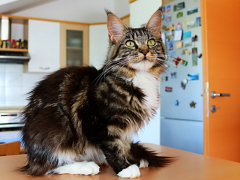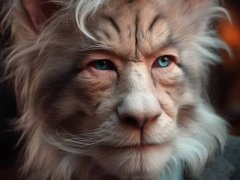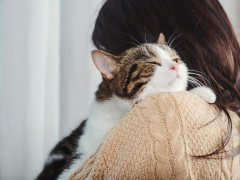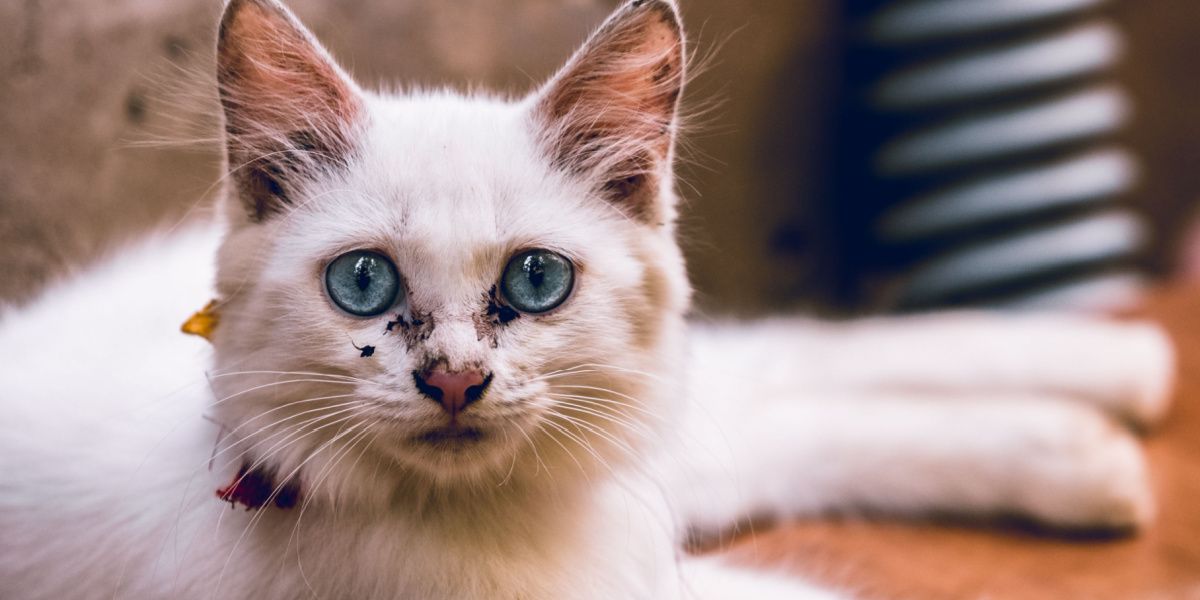
I’m sure all of us would agree that cats’ eyes are stunningly beautiful; however, you may notice something concerning as you gaze lovingly at your feline companion – a build-up of gunk or discharge in the corner of their eyes (also known as eye boogers).
Cat eye boogers are caused by an accumulation of mucus and dried tears in the corner of the eyes. While small amounts of eye boogers may be normal, any change in the volume, color, or consistency of your cat's eye boogers may indicate a problem with their eyes. Eye boogers can be gently cleaned away using water on cotton wool balls.Key Takeaways
In this article, we will discuss the causes of eye boogers, how to remove and prevent them, as well as warning signs that your cat needs to be checked by their veterinarian.
What Are Eye Boogers in Cats?
Most people will be familiar with the gunk that collects in the corners of their own eyes, especially after they have been asleep. Well, cats can also have a build-up of secretions in the same place – this is commonly referred to as eye boogers, eye goop, eye gunk, or sleep.
Cats’ precious eyes are protected from dirt, dust, foreign materials, chemicals, viruses, and bacteria by a film of tears that contain water, salts, protein, mucus, and fatty oils. While they are awake tears are distributed over the eye when the cat blinks, and then removed via the tear ducts, or by evaporation. Sometimes (especially during sleep), the components of tears, such as mucus, precipitate out and collect in the corners of the eyes – resulting in eye boogers.
Are Eye Boogers Normal in Cats?
Healthy feline eyes should be bright and clear, but eye boogers are normal in small amounts, especially after your cat has been snoozing. It is also normal for there to be some variation in the appearance of cat eye boogers – some may be sticky and moist, while other cats may have small amounts of darker, crusty material at the corners.
Certain cat breeds like Persians and Himalayans are more prone to having eye boogers, as their flatter faces and large eyes often lead to improper tear drainage. It is still important to check with your veterinarian that they consider the amount of eye boogers to be normal for these breeds, as they can also suffer from other eye conditions.
How To Clean Your Cat’s Eye Boogers
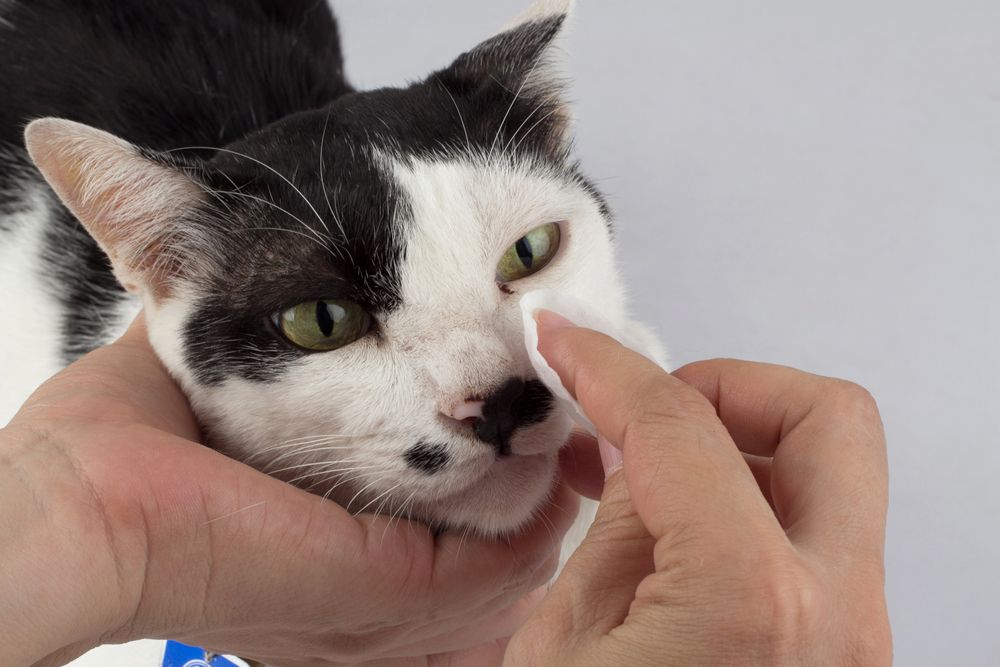
Cats prone to eye boogers may need their eyes wiping regularly
In kitties prone to eye boogers you can follow these simple steps to safely clean them away:
- Boil some water then allow it to cool
- Wash your hands with soap and water
- Dip a cotton ball in the pre-boiled water
- Gently wipe away discharge, starting from the inner corner of the eye and wiping outwards
- Follow the grain of the fur when wiping
- Repeat for the other eye with a fresh cotton wool ball
Alternatively, you can use eye-safe pet wipes to clean around your cat’s delicate eye area.
When Are Eye Boogers Something To Worry About?
Although small amounts of eye boogers can be normal in kitties, eye discharge in cats can be a sign of something more serious. If you notice that there is an increase in the amount of eye boogers your cat is producing, or they change in color or consistency, you should contact your veterinarian without delay.
Excess discharge from the eyes, along with pawing at the eyes, excessive blinking, redness, squinting, and swelling are all symptoms of potentially very serious ocular conditions:
- Foreign bodies: objects such as grass awns can get lodged in the eye causing irritation and excessive tearing.
- Excessive tearing: watery discharge can be caused by many conditions such as blocked tear ducts and allergies (e.g. to pollen).
- Feline upper respiratory infections: viruses, including feline herpesvirus and feline calicivirus, and other infections such as rhinotracheitis, bacteria, and protozoa can all cause an increase in eye discharge as well as respiratory symptoms such as sneezing.
- Eyelid abnormalities: structural changes such as entropion where the eyelids fold inwards can cause irritation to the eyes.
- Conjunctivitis: this has many causes including bacterial and viral infections, and leads to inflammation of the pink lining around cats’ eyes.
- Corneal ulcers: painful ulceration can be caused by trauma or certain viral infections.
- Uveitis: an inflammatory condition of the internal structures of the eye leading to a red, painful eye, often with excessive discharge. It can be caused by trauma, infections, and even some cancers.
When To Call Your Cat’s Veterinarian
Get your cat checked by their veterinarian if you notice any change in the normal appearance of their eyes or the amount or type of their eye boogers. If your pet is showing any of the following symptoms, in addition to an increase in the amount of their eye boogers, you should seek veterinary advice urgently:
- Squinting their eye(s), or holding them completely shut
- Red, inflamed eye(s)
- Swollen eye(s)
- Pus-like eye discharge
- Cloudiness of the corneas (surface of the eyes)
- Vision trouble, or appearing to be blind
- Trouble breathing
- Poor appetite
- Lethargy
- Fever
Prevention of Eye Boogers in Cats
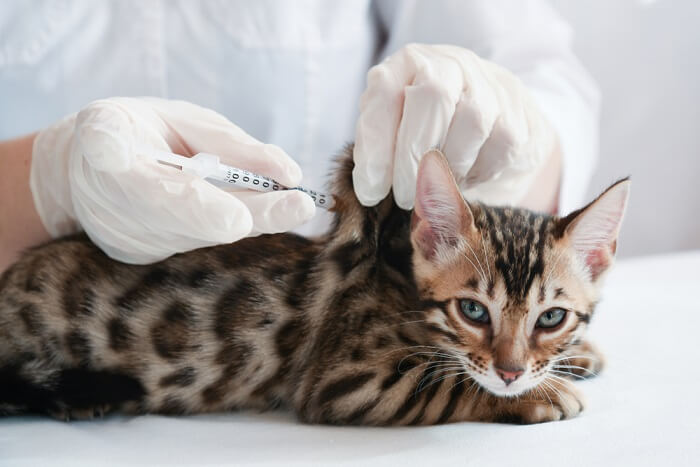
It is recommended to vaccinate cats against some viral infections which can cause ocular symptoms
Although you can not do anything to prevent the small amount of normal eye boogers seen in some cats, regular health checks with their veterinarian and vaccinations to prevent contagious respiratory diseases (such as feline herpes virus) are both ways that you can try to keep your cat’s gorgeous eyes as discharge-free as possible.
If your cat is suffering from excessive eye boogers, getting a diagnosis of the underlying cause from your veterinarian should enable treatment to resolve the problem. This may be as simple as eye drops for an eye infection or may require further testing and investigations for some of the infections that cause uveitis such as feline infectious peritonitis (FIP).
Cats, just like their owners, can be prone to small amounts of normal mucus-like secretions collecting at the corner of their eyes (often referred to as eye boogers, sleep, or eye gunk). Certain breeds such as Persians are more likely to have noticeable amounts of eye boogers due to their face and eye anatomy – requiring regular gentle cleaning by their owners. A change in the amount or type of eye boogers, or eye discharge, should always be checked out by your veterinarian as it may indicate a serious eye condition.
Frequently Asked Questions
Is it normal for my cat to have eye boogers every day?
Eye boogers are the remains of mucus and debris from the tear film, and a small amount is considered normal in healthy cats. If the amount seems excessive, or your cat is showing any signs of ocular irritation, you should always get them checked by their veterinarian.
Should I clean my cat’s eye boogers?
For most cats with tiny amounts of normal eye boogers, there is no need to clean them as they will probably do it themselves. For certain cat breeds that are more prone to eye boogers such as Persians, it is a good idea to clean them daily to keep the eyes and surrounding skin clean and healthy.
Should I take my cat to the vets for eye boogers?
If you have any concerns over your cat’s eyes you should always take them for a check-up with their veterinarian. While it can be normal for cats to have a small amount of eye boogers at the inner corners of their eyes, if the amount, color, or consistency of them changes you should consult their veterinarian. Any sign of painful, swollen, inflamed, or red eyes should always be checked out, as well as cats that are also showing symptoms such as sneezing, poor appetite, diarrhea, or lethargy.




